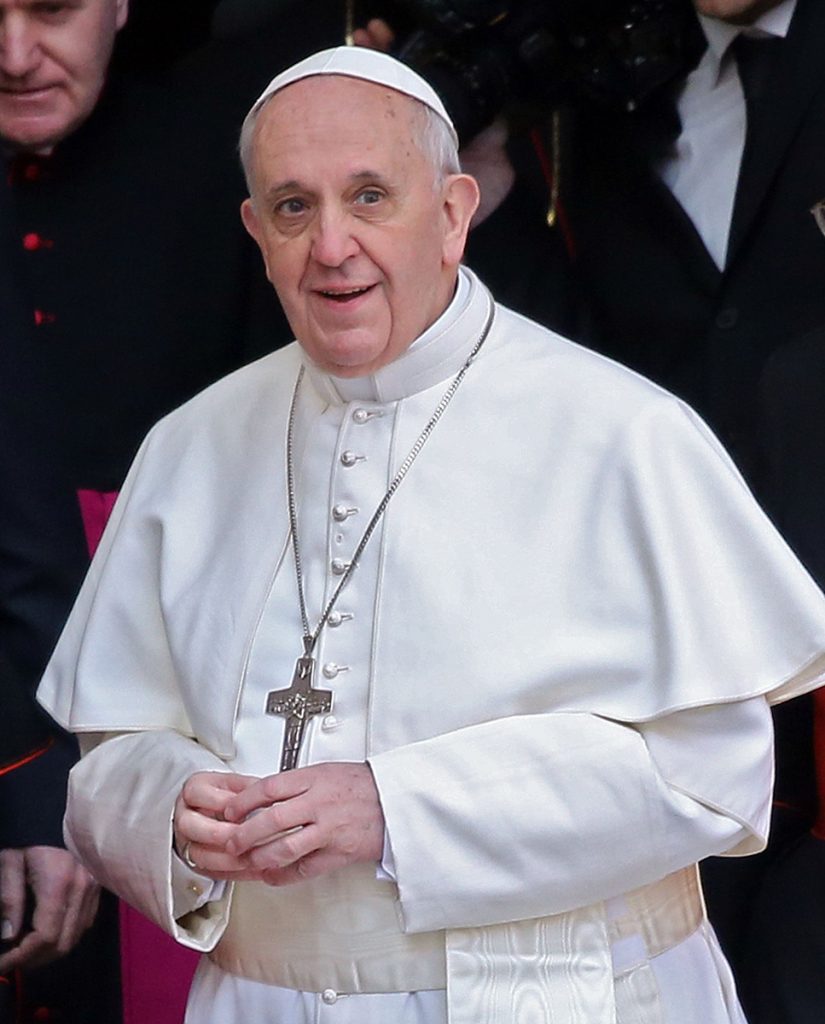Pope Names Bank Commission
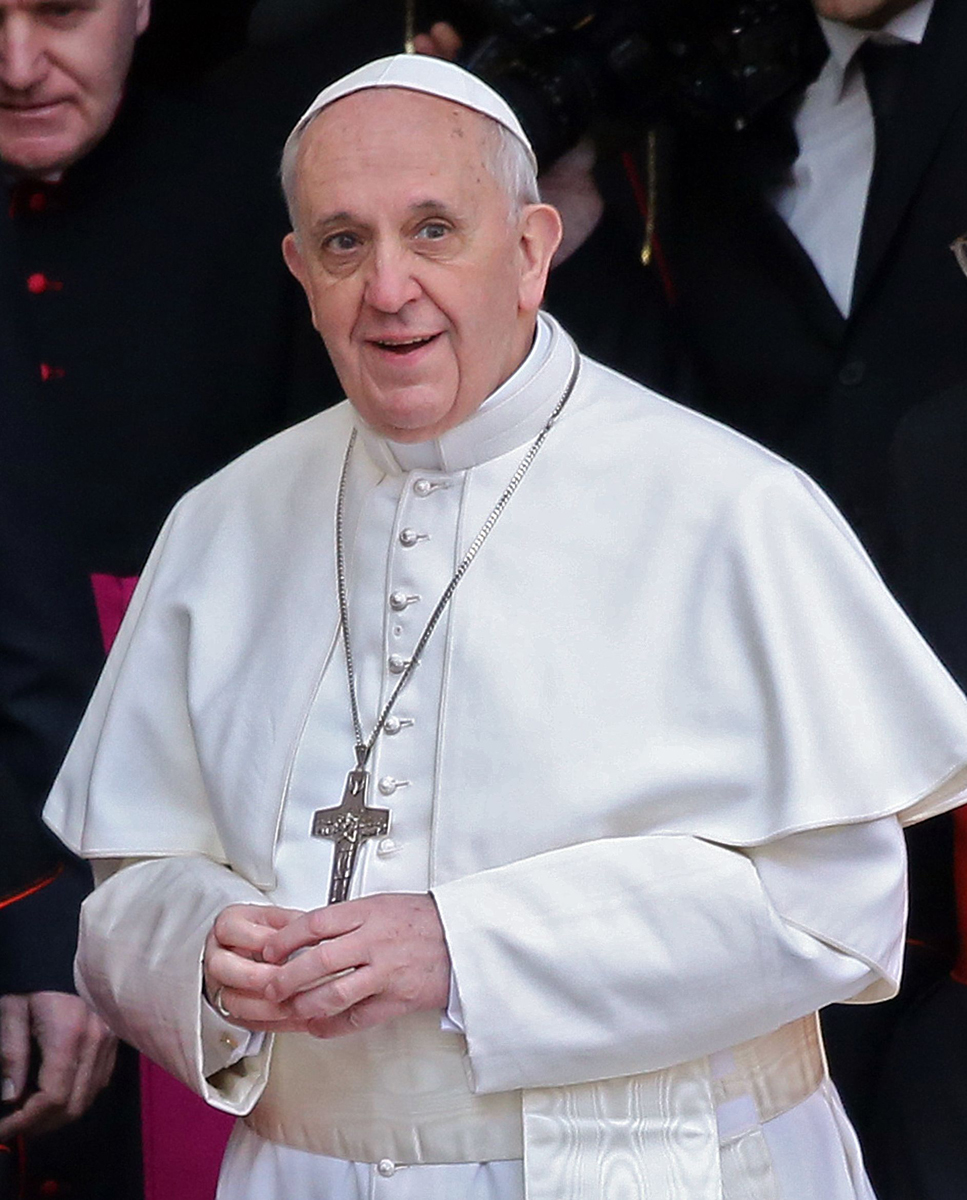
Pope Francis has created a five-person commission to review the activities and mission of the Vatican bank. The new pontifical commission, which includes two U.S. members, reflects the pope’s desire to ensure the bank’s activities are in harmony with the mission of the universal church and the Apostolic See, said a Vatican communique published June 26. The commission’s aim is “to collect information on the running of the Institute” for the Works of Religion, the formal name of the Vatican bank, and then to present the results to Pope Francis. The commission, which includes Mary Ann Glendon, a Harvard law professor, and Msgr. Peter B. Wells, a top official in the Vatican Secretariat of State, is to have wide and unencumbered access to all “documents, data, information,” the Vatican said.
Giant Buddha of Leshan

The Giant Buddha of Leshan (aka Dafo) is the tallest stone Buddha statue in the world, carved out of a cliff face by an 8th-century monk in southern Szechuan province. The Giant Buddha overlooks the confluence of the Minjiang, Dadu and Qingyi rivers and faces the sacred Mount Emei (with which it shares its World Heritage status).
History
Construction on the Giant Buddha began in 713 AD. It was the idea of a Chinese monk named Haitong, who hoped that the Buddha would calm the turbulent waters that plagued the shipping vessels travelling down the river. His plans were not just supernatural – the enormous amount of rubble carved away from the cliff would be deposited in the river, altering the currents and calming the waters.
When government funding for the project was threatened, the monk is said to have gouged out his own eyes to show his piety and sincerity. The construction project was continued by his disciples and finally completed by the local governor in 803.
Today, there are still some strong currents where the three rivers meet – but none that threaten the tourist ferries. The “Mount Emei Scenic Area with Leshan Giant Buddha” was listed as a UNESCO World Heritage Site in 1996.
What to See
Known as Dafo, the statue depicts a seated Maitreya Buddha with his hands resting on his knees, gazing across the river with heavy-lidded eyes. Maitreya is the future Buddha, who will appear to preach the dharma when the teachings of Gautama Buddha have faded away. He was especially popular during the 4th to 7th centuries and his images can be found throughout the Buddhist world, conveying his characteristic air of expectancy and promise.
Standing 71 meters (233 feet) tall, Dafo is the tallest Buddha statue in the world. His shoulders are 28 meters (92 feet) wide and his smallest toenail can accommodate a seated person. Each eyebrow is 18 feet long. According to a local saying, “The mountain is a Buddha and the Buddha is a mountain.”
Several drainage passages hidden in the Buddha’s hair, collar, chest, and holes in the back of his ears preventing the Buddha from serious erosion and weathering. He has been lovingly maintained on a regular basis throughout his 1,200-year history, but is still a bit mossy.
Visitors stare in awe at the Buddha from the tourist ferries and from a terrace next to his ear. On one side of the terrace is a modern statue of the monk Haitong, and behind is the Lingyun Temple Museum with exhibits on the construction and renovations of Dafo.
South of the Giant Buddha is Wuyou Si, which visitors pass on the way from the ferry to the Buddha. A pink-walled monastery founded in 742 AD, it has impressive decorations including splendid gate guardians, painted scenes from the Journey to the West (on the second hall) and amusing sculptures of arhats (inside the Louhan Hall).
On the other side of the gully on Lingyun Shan, there are signs for Han-dynasty tomb chambers, which suggest this site was sacred before the Buddha was carved.
Requiem Mass for victims of Italy bus crash
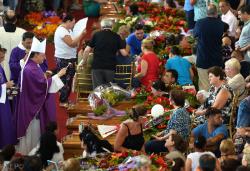
Thousands of people packed into a sports hall in the southern Italian town of Pozzuoli to take part in a Requiem Mass for the 38 people who died when a coach plunged 25 metres off a motorway viaduct in one of the worst road accidents in Italian history.
An estimated 4,000 mourners attended the Requiem Mass, which was offered by the Bishop of Pozzuoli, Gennaro Pescarella.
Earlier, Pope Francis sent a telegram of condolence for the victims, saying he shared the “profound pain that has struck the Campania region” and ensuring his “fervent prayers for the many victims”. He prayed for eternal rest for those who had died, healing for the injured, and comfort for those who are mourning the loss of loved ones.
Many of the victims, including numerous young children, came
from Pozzuoli, just outside the southern city of Naples, and
many were related, adding to the sense of loss in the sweltering
hall where the funeral was held.
Prosecutors have opened an investigation into the accident
focusing on suspicions of manslaughter, but no charges have been
laid and no clear indications have yet emerged as to what may
have caused the crash.
Listen to Christopher Wells’ report
World Day of Peace:

Pope Francis on Wednesday announced the theme for the celebration of the 47th World Day of Peace.
The theme chosen for this occurence, celebrated every year on January 1, is : “Fraternity, the foundation and pathway to peace”. It’s the first World Day of Peace to be celebrated during the pontificate of Pope Francis.
The World Day of Peace was an initiative of Pope Paul VI and it is celebrated on the first day of each year. The Message for the World Day of Peace is sent to particular churches and chancelleries all around the world, drawing attention to the essential value of peace and the need to work tirelessly in order to attain it.
As the theme of his first Message for the World Day of Peace, Pope Francis has chosen Fraternity. Since the beginning of his Petrine Ministry, the Pope has stressed the need to combat the “throwaway culture” and to promote instead a “culture of encounter”, in order to build a more just and peaceful world.
Fraternity is a dowry that every man and every woman brings with himself or herself as a human being, as a child of the one Father. In the face of the many tragedies that afflict the family of nations – poverty, hunger, underdevelopment, conflicts, migrations, pollution, inequalities, injustice, organized crime, fundamentalisms – fraternity is the foundation and the pathway to peace.
The culture of personal well-being leads to a loss of the sense of responsibility and fraternal relationship. Others, rather than being “like us”, appear more as antagonists or enemies and are often treated as objects. Not uncommonly, the poor and needy are regarded as a “burden”, a hindrance to development. At most, they are considered as recipients of aid or compassionate assistance. They are not seen as brothers and sisters, called to share the gifts of creation, the goods of progress and culture, to be partakers at the same table of the fullness of life, to be protagonists of integral and inclusive development.
Fraternity, a gift and task that comes from God the Father, urges us to be in solidarity against inequality and poverty that undermine the social fabric, to take care of every person, especially the weakest and most defenceless, to love him or her as oneself, with the very heart of Jesus Christ.
In a world that is constantly growing more interdependent, the good of fraternity is one that we cannot do without. It serves to defeat the spread of the globalization of indifference to which Pope Francis has frequently referred. The globalization of indifference must give way to a globalization of fraternity.
Fraternity should leave its mark on every aspect of life, including the economy, finance, civil society, politics, research, development, public and cultural institutions.
At the start of his ministry, Pope Francis issues a message in continuity with that of his predecessors, which proposes to everyone the pathway of fraternity, in order to give the world a more human face.
【R.I.P.】Fr. Ignatius Shen Tung-pai went to the Lord
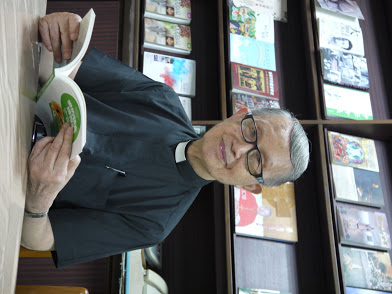
Fr. Ignatius Shen Tung-pai went peacefully to the Lord on July 31, 2013 at the Infirmary in Taipei at 8:45 p.m.
Fr. Shen was born in P’utong (Pudong), Shanghai, on Mar. 19, 1920. He entered the Society in Zikawei, Shanghai, on Aug. 30, 1942, was ordained to the priesthood on Mar. 18, 1955 at Baguio, Philippines, and made the last vows on Feb. 2, 1958 in Manila.
Yours in Our Lord,
John Lee Hua, S.J.
Provincial
July 31, 2013
【R.I.P.】Fr. Ignatius Shen Tung-pai went to the Lord
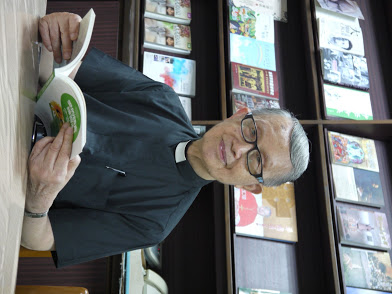
Fr. Ignatius Shen Tung-pai went peacefully to the Lord on July 31, 2013 at the Infirmary in Taipei at 8:45 p.m.
Fr. Shen was born in P’utong (Pudong), Shanghai, on Mar. 19, 1920. He entered the Society in Zikawei, Shanghai, on Aug. 30, 1942, was ordained to the priesthood on Mar. 18, 1955 at Baguio, Philippines, and made the last vows on Feb. 2, 1958 in Manila.
All priests of the Chinese Province will celebrate one Mass first intention for Fr. Shen’s eternal rest. Those who are not priests will offer one Mass and Communion and recite one “corona”. The members of Tainan – Kaohsiung community will offer two Masses, etc.
Yours in Our Lord,
Luciano Morra, S.J.
Socius
July 31, 2013
The Life of St. Ignatius of Loyola

Early Life of St. Ignatius
Inigo de Loyola was born in 1491 in Azpeitia in the Basque province of Guipuzcoa in northern Spain. He was the youngest of thirteen children. At the age of sixteen years he was sent to serve as a page to Juan Velazquez, the treasurer of the kingdom of Castile. As a member of the Velazquez household, he was frequently at court and developed a taste for all it presented, especially the ladies. He was much addicted to gambling, very contentious, and not above engaging in swordplay on occasion. In fact in a dispute between the Loyolas and another family, Ignatius and his brother plus some relatives ambushed at night some clerics who were members of the other family. Ignatius had to flee the town. When finally brought to justice he claimed clerical immunity using the defense that he had received the tonsure as a boy, and was therefore exempt from civil prosecution. The defense was specious because Ignatius had for years gone about in the dress of a fighting man, wearing a coat of mail and breastplate, and carrying a sword and other sorts of arms – certainly not the garb normally worn by a cleric. The case dragged on for weeks, but the Loyolas were apparently powerful. Probably through the influence of higher-ups, the case against Ignatius was dropped.
Eventually he found himself at the age of 30 in May of 1521 as an officer defending the fortress of the town of Pamplona against the French, who claimed the territory as their own against Spain. The Spaniards were terribly outnumbered and the commander of the Spanish forces wanted to surrender, but Ignatius convinced him to fight on for the honor of Spain, if not for victory. During the battle a cannon ball struck Ignatius, wounding one leg and breaking the other. Because they admired his courage, the French soldiers carried him back to recuperate at his home, the castle of Loyola, rather than to prison.
His leg was set but did not heal, so it was necessary to break it again and reset it, all without anesthesia. Ignatius grew worse and was finally told by the doctors that he should prepare for death.
On the feast of Saints Peter and Paul (29 June) he took an unexpected turn for the better. The leg healed, but when it did the bone protruded below the knee and one leg was shorter than the other. This was unacceptable to Ignatius, who considered it a fate worse than death not to be able to wear the long, tight-fitting boots and hose of the courtier. Therefore he ordered the doctors to saw off the offending knob of bone and lengthen the leg by systematic stretching. Again, all of this was done without anesthesia. Unfortunately, this was not a successful procedure. All his life he walked with a limp because one leg was shorter than the other.
Conversion of St. Ignatius
During the long weeks of his recuperation, he was extremely bored and asked for some romance novels to pass the time. Luckily there were none in the castle of Loyola, but there was a copy of the life of Christ and a book on the saints. Desperate, Ignatius began to read them. The more he read, the more he considered the exploits of the saints worth imitating. However, at the same time he continued to have daydreams of fame and glory, along with fantasies of winning the love of a certain noble lady of the court, the identity of whom we never have discovered but who seems to have been of royal blood. He noticed, however, that after reading and thinking of the saints and Christ he was at peace and satisfied. Yet when he finished his long daydreams of his noble lady, he would feel restless and unsatisfied. Not only was this experience the beginning of his conversion, it was also the beginning of spiritual discernment, or discernment of spirits, which is associated with Ignatius and described in his Spiritual Exercises.
The Exercises recognize that not only the intellect but also the emotions and feelings can help us to come to a knowledge of the action of the Spirit in our lives. Eventually, completely converted from his old desires and plans of romance and worldly conquests, and recovered from his wounds enough to travel, he left the castle in March of 1522.
He had decided that he wanted to go to Jerusalem to live where our Lord had spent his life on earth. As a first step he began his journey to Barcelona. Though he had been converted completely from his old ways, he was still seriously lacking in the true spirit of charity and Christian understanding, as illustrated by an encounter he had with a Moor on his way. The Moor and he came together on the road, both riding mules, and they began to debate religious matters. The Moor claimed that the Blessed Virgin was not a virgin in her life after Christ was born. Ignatius took this to be such an insult that he was in a dilemma as to what to do. They came to a fork in the road, and Ignatius decided that he would let circumstances direct his course of action. The Moor went down one fork. Ignatius let the reins of his mule drop. If his mule followed the Moor, he would kill him. If the mule took the other fork he would let the Moor live. Fortunately for the Moor, Ignatius’ mule was more charitable than its rider and took the opposite fork from the Moor.
He proceeded to the Benedictine shrine of Our Lady of Montserrat, made a general confession, and knelt all night in vigil before Our Lady’s altar, following the rites of chivalry. He left his sword and knife at the altar, went out and gave away all his fine clothes to a poor man, and dressed himself in rough clothes with sandals and a staff.
The Experience at Manresa
He continued towards Barcelona but stopped along the river Cardoner at a town called Manresa. He stayed in a cave outside the town, intending to linger only a few days, but he remained for ten months. He spent hours each day in prayer and also worked in a hospice. It was while here that the ideas for what are now known as the Spiritual Exercises began to take shape. It was also on the banks of this river that he had a vision which is regarded as the most significant in his life. The vision was more of an enlightenment, about which he later said that he learned more on that one occasion than he did in the rest of his life. Ignatius never revealed exactly what the vision was, but it seems to have been an encounter with God as He really is so that all creation was seen in a new light and acquired a new meaning and relevance, an experience that enabled Ignatius to find God in all things. This grace, finding God in all things, is one of the central characteristics of Jesuit spirituality.
Ignatius himself never wrote in the rules of the Jesuits that there should be any fixed time for prayer. Actually, by finding God in all things, all times are times of prayer. He did not, of course, exclude formal prayer, but he differed from other founders regarding the imposition of definite times or duration of prayer. One of the reasons some opposed the formation of the Society of Jesus was that Ignatius proposed doing away with the chanting of the Divine Office in choir. This was a radical departure from custom, because until this time, every religious order was held to the recitation of the office in common. For Ignatius, such recitation meant that the type of activity envisioned for the Society would be hindered. Some time after the death of Ignatius, a later Pope was so upset about this that he imposed the recitation of the Office in common on the Jesuits. Fortunately, the next Pope was more understanding and allowed the Jesuits to return to their former practice.
It was also during this period at Manresa, still lacking in true wisdom concerning holiness, that he undertook many extreme penances, trying to outdo those he had read of in the lives of the saints. It is possible that some of these penances, especially his fasting, ruined his stomach, which troubled him the rest of his life. He had not yet learned moderation and true spirituality. This is probably why the congregation he later founded did not have any prescribed or set penances, as other orders had.
He finally arrived at Barcelona, took a boat to Italy, and ended up in Rome where he met Pope Adrian VI and requested permission to make a pilgrimage to the Holy Land. Once he arrived in the Holy Land he wanted to remain, but was told by the Franciscan superior who had authority over Catholics there that the situation was too dangerous. (Remember, the Turks were the rulers of the Holy Land.) The superior ordered Ignatius to leave. Ignatius refused but when threatened with excommunication, he obediently departed.
The Return to School
By now he was 33 years old and determined to study for the priesthood. However, he was ignorant of Latin, a necessary preliminary to university studies in those days. So he started back to school studying Latin grammar with young boys in a school in Barcelona. There he begged for his food and shelter. After two years he moved on to the University of Alcala. There his zeal got him into trouble, a problem that continued throughout his life. He would gather students and adults to explain the Gospels to them and teach them how to pray. His efforts attracted the attention of the Inquisition and he was thrown into jail for 42 days. When he was released he was told to avoid teaching others. The Spanish Inquisition was a bit paranoid and anyone not ordained was suspect (as well as many who were ordained).
Because he could not live without helping souls, Ignatius moved on to the University of Salamanca. There, within two weeks, the Dominicans had thrown him back into prison again. Though they could find no heresy in what he taught, he was told that he could only teach children and then only simple religious truths. Once more he took to the road, this time for Paris.
At the University of Paris he began school again, studying Latin grammar and literature, philosophy, and theology. He would spend a couple of months each summer begging in Flanders for the money he would need to support himself in his studies for the rest of the year. It was also in Paris that he began sharing a room with Francis Xavier and Peter Faber. He greatly influenced a few other fellow students (Xavier was the hardest nut to crack, interested as he was mainly in worldly success and honors), directing them all at one time or another for thirty days in what we now call the Spiritual Exercises. Eventually six of them plus Ignatius decided to take vows of chastity and poverty and to go to the Holy Land. If going to the Holy Land became impossible, they would then go to Rome and place themselves at the disposal of the Pope for whatever he would want them to do. They did not think of doing this as a religious order or congregation, but as individual priests. For a year they waited, however no ship was able to take them to the Holy Land because of the conflict between the Christians and Muslims. While waiting they spent some time working in hospitals and teaching catechism in various cities of northern Italy. It was during this time that Ignatius was ordained a priest, but he did not say Mass for another year. It is thought that he wanted to say his first Mass in Jerusalem in the land where Jesus himself had lived.
The Company of Jesus
Ignatius, along with two of his companions, Peter Faber and James Lainez, decided to go to Rome and place themselves at the disposal of the Pope. It was a few miles outside of the city that Ignatius had the second most significant of his mystical experiences. At a chapel at La Storta where they had stopped to pray, God the Father told Ignatius, “I will be favorable to you in Rome” and that he would place him (Ignatius) with His Son. Ignatius did not know what this experience meant, for it could mean persecution as well as success since Jesus experienced both. But he felt very comforted since, as St. Paul wrote, to be with Jesus even in persecution was success. When they met with the Pope, he very happily put them to work teaching scripture and theology and preaching. It was here on Christmas morning, 15 3 8, that Ignatius celebrated his first Mass at the church of St. Mary Major in the Chapel of the Manger. It was thought that this chapel had the actual manger from Bethlehem, so, if Ignatius was not going to be able to say his first Mass at Jesus’ birthplace in the Holy Land, then this would be the best substitute.
During the following Lent (1539), Ignatius asked all of his companions to come to Rome to discuss their future. They had never thought of founding a religious order, but now that going to Jerusalem was out, they had to think about their future – whether they would spend it together. After many weeks of prayer and discussion, they decided to form a community, with the Pope’s approval, in which they would vow obedience to a superior general who would hold office for life. They would place themselves at the disposal of the Holy Father to travel wherever he should wish to send them for whatever duties. A vow to this effect was added to the ordinary vows of poverty, chastity and obedience. Formal approval of this new order was given by Pope Paul III the following year on September 27, 1540. Since they had referred to themselves as the Company of Jesus (in Latin Societatis Jesu), in English their order became known as the Society of Jesus. Ignatius was elected on the first ballot of the group to be superior, but he begged them to reconsider, pray and vote again a few days later. The second ballot came out as the first, unanimous for Ignatius, except for his own vote. He was still reluctant to accept, but his Franciscan confessor told him it was God’s will, so he acquiesced. On the Friday of Easter week, April 22,1541, at the Church of St. Paul Outside-the-Walls, the friends pronounced their vows in the newly formed Order.
The Last Years
Ignatius, whose love it was to be actively involved in teaching catechism to children, directing adults in the Spiritual Exercises, and working among the poor and in hospitals, would for the most part sacrifice this love for the next fifteen years – until his death – and work out of two small rooms, his bedroom and next to it his office, directing this new society throughout the world. He would spend years composing the Constitutions of the Society and would write thousands of letters to all corners of the globe to his fellow Jesuits dealing with the affairs of the Society and to lay men and women directing them in the spiritual life. From his tiny quarters in Rome he would live to see in his lifetime the Society of Jesus grow from eight to a thousand members, with colleges and houses all over Europe and as far away as Brazil and Japan. Some of the original companions were to become the Pope’s theologians at the Council of Trent, an event which played an important role in the Catholic Counter Reformation.
At first Ignatius wrote his own letters, but as the Society grew in numbers and spread over the world, it became impossible to communicate with everyone and still run the new order. Therefore a secretary, Fr. Polanco, was appointed in 1547 to help him in his correspondence. We know that Ignatius wrote almost 7,000 letters during his lifetime, the vast majority of them after he became the Superior General of the Jesuits. Ignatius considered the correspondence between members of the Jesuits one of the most important elements in fostering unity. Separation of Jesuits throughout the world was one of the greatest dangers to the growth, apostolate and unity of the Society. He not only wrote, therefore, to all the houses of the Order, but he also required the various superiors throughout the world to write to Rome regularly, informing him of what was happening. This information could be passed on to the houses of the Society everywhere.
In his letters to members of the Society, he treated each one as an individual. He was overly kind and gentle with those who gave him the most problems. On the other hand, with those who were the holiest and humblest, he seemed at times to be too harsh, obviously because he knew they were able to take his corrections without rancor, knowing that Ignatius loved them and was looking only to their greater spiritual good. Fr. James Lainez, one of Ignatius’ original companions, was the provincial in northern Italy. He had done a couple of things that put Ignatius on the spot, including making commitments that Ignatius could not fulfill. In addition, Lainez had expressed his disagreement to others about a change of personnel which Ignatius made.
Ignatius wrote to Lainez through his secretary Polanco: “He, (Ignatius) has told me to write to you and tell you to attend to your own office, which if you do well, you will be doing more than a little. You are not to trouble yourself in giving your view of his affairs, as he does not want anything of the kind from you unless he asks for it, and much less now than before you took office, since your administration of your own province has not done much to increase your credit in his eyes. Examine your mistakes in the presence of God our Lord, and for three days take some time for prayer to this end.” So much for saints being all sugar and spice.
It was to Lainez’ credit that he took this severe reproof with humility and grace, asking to be assigned several harsh penances, such as being removed from office and being assigned the meanest job possible in the Society. Ignatius never even referred to the incident again, leaving Lainez to carry on as before. Lainez was to succeed Ignatius as the second Superior General of the Jesuits.
A superior of somewhat less humility than Lainez could not see the importance of writing to Rome of all the happenings in his house. With tact and kindness, so as not to hurt the superior’s feelings, but perhaps with a touch of sarcasm, Ignatius wrote: “It will not be a matter of surprise to you to learn that reproofs are sometimes sent out from Rome … If I have to dwell at some length on them, do not lay the blame on your own desserts alone, but also on the concept that has been formed here of your fortitude, in the sense that you are a man to whom can be said whatever needs saying … you did well to observe obedience in the matter of writing every week… What you should have done was to try to find someone, once the letters were written, to carry and deliver them.”
While zealous to bring people to God and to help them spiritually, Ignatius still remained a person of practicality and common sense. A Jesuit had complained of having trouble with overly pious people who monopolized his time for no good reason. Through Polanco, Ignatius instructed him on how to deal charitably with such people without giving offense. “Our father (Ignatius) made another remark as to how to free oneself from one whom there was no hope of helping. He suggests talking to him rather pointedly of hell, judgement and such things. In that case he would not return, or, if he did, the chances are that he would feel himself touched in our Lord.”
There was a bishop who had a great animosity to the Society. He refused to have this new Order in his diocese, and he excommunicated anyone who made the Spiritual Exercises. He was known as Bishop “Cilicio” by the Jesuits (that is, “the hairshirt bishop”). Ignatius told the Jesuits who were worried about his attitude to relax. “Bishop Cilicio is an old man. The Society is young. We can wait.”
The Jesuits and Schools
Perhaps the work of the Society of Jesus begun by Ignatius that is best known is that of education, yet it is interesting that he had no intention of including teaching among the Jesuits’ works at the beginning. As already mentioned, the purpose of the first members was to be at the disposal of the Pope to go where they would be most needed. Before 1548 Ignatius had opened schools in Italy, Portugal, the Netherlands, Spain, Germany, and India, but they were intended primarily for the education of the new young Jesuit recruits. Ten such colleges within six years indicated the rapid growth of the Jesuits. But in 1548 at the request of the magistrates of Messina in Sicily, Ignatius sent five men to open a school for lay as well as Jesuit students. It soon became clear by requests from rulers, bishops and cities for schools that this work was truly one of the most effective ways to correct ignorance and corruption among the clergy and faithful, to stem the decline of the Church in the face of the Reformation, and to fulfill the motto of the Society of Jesus, “Ad Majorem Dei Gloriam,” – to the greater glory of God.
Ignatius expressed this in a letter to Fr. Araoz, “The more universal the good is, the more it is divine. Therefore preference ought to be given to those persons and places which, through their own improvement, become a cause which can spread the good accomplished to many others who are under their influence or take guidance from them … For the same reason, too, preference ought to be shown to the aid which is given to … universities, which are generally attended by numerous persons who by being aided themselves can become laborers for the help of others.”
This was in keeping with one of Ignatius’ first principles in choosing apostolates: all other things being equal, choose those apostolates that will influence those who have the most influence on others. Maybe the best expression of this idea was in a letter he wrote about the founding of colleges in December of 1551: “From among those who are now merely students, in time some will depart to play diverse roles – one to preach and carry on the care of souls, another to government of the land and the administration of justice, and others to other callings. Finally, since young boys become grown men, their good education in life and doctrine will be beneficial to many others, with the fruit expanding more widely every day.” From then on, Ignatius helped establish Jesuit schools and universities all over Europe and the world.
Ignatius as a Man
It is probably true that the picture of Ignatius that most people have is that of a soldier: stern, iron-willed, practical, showing little emotion – not a very attractive or warm personality. Yet if this picture is exact, it is hard to see how he could have had such a strong influence on those who knew him. Luis Goncalves de Camara, one of his closest associates, wrote, “He (Ignatius) was always rather inclined toward love; moreover, he seemed all love, and because of that he was universally loved by all. There was no one in the Society who did not have great love for him and did not consider himself much loved by him.”
He sometimes cried so much at Mass that he could not go on, nor even talk for some time, and he was afraid that his gift of tears might cause him to lose his eyesight. Goncalves de Camara said, “When he did not weep three times during Mass, he considered himself deprived of consolation.” We regard a number of saints as great mystics but never think of Ignatius as one of them. We have recounted a few of the many visions and mystical experiences in his life. His holiness, however, did not consist in such, but in the great love that directed his life to do everything A.M.D.G., for the greater glory of God.
Last Illness
Ever since his student days in Paris, Ignatius had suffered from stomach ailments and they became increasingly troublesome in Rome. In the summer of 1556 his health grew worse, but his physician thought he would survive this summer as he had done others. Ignatius, however, thought that the end was near. On the afternoon of July 30th he asked Polanco to go and get the Pope’s blessing for him, suggesting by this to Polanco that he was dying. Polanco, however, trusted the physician more than Ignatius and told him that he had a lot of letters to write and mail that day. He would go for the Pope’s blessing the next day. Though Ignatius indicated that he would prefer he (Polanco) go that afternoon, he did not insist. Shortly after midnight Ignatius took a turn for the worse. Polanco rushed off to the Vatican to get the papal blessing, but it was too late. The former worldly courtier and soldier who had turned his gaze to another court and a different type of battle had rendered his soul into the hands of God. Ignatius was beatified on July 27, 1609 and canonized by Pope Gregory XV on March 12, 1622 together with St. Francis Xavier. Ignatius’ feast day is celebrated by the universal Church and the Jesuits on July 31, the day he died.
Pope Francis:Go, do not be afraid, and serve
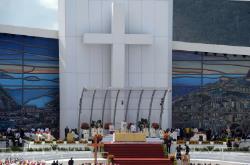
Celebrating the World Youth Day Holy Mass in Rio de Janeiro on Sunday, Pope Francis told those present that it was time to go and to pass on this experience to others.
Addressing a crowd of over 3 million people gathered on Copacabana beachfront for the concluding Mass of the weeklong event, the Pope focused his message on the very theme chosen to run through World Youth Day: “Go and make disciples of all nations”.
State Farm Shouldn’t Be the Only Good Neighbor
For years, State Farm Insurance has promoted itself as being a “good neighbor” with its popular jingle, “like a good neighbor, State Farm is there.”

The gospel for this Sunday challenges us to be a good neighbor but adds a definition for what it means to be a good neighbor: it means to be one who shows mercy. Being a good neighbor means more than just maintaining a clean lawn and keeping the noise down. To show mercy is to show compassion and compassion is not something that can be legislated or scheduled in some legalistic manner: it must flow from the heart. At the same time, our hearts need to be predisposed to showing mercy lest they grow hardened. We need to practice being a good neighbor – by showing mercy – to those in need. That all begins by being more aware of the needs of others in the same way that God has responded to our needs with mercy.
On his blog, Living Sacrifice, Rev. Christopher Mahar encourages us to practice Spiritual Works of Mercy as a way of being a good neighbor. He offers the following reflection questions which I find very fitting in terms of raising our awareness of those in need.
1. To counsel the doubtful
Are there any people in our lives who right now doubt their faith in God or their ability and desire to live out that faith in the Church? Are there people in our lives that are no longer convinced that God is close to them and really wants to lead them to joy and peace? We should never underestimate what a word of encouragement or counsel can do for them.
2. To instruct the ignorant
Are there people today who are ignorant of the greatest truths that God has revealed to us through Christ, truths that have been passed down to us through the apostles and have the power to lead us to eternal life? By all means, yes. Is there some small way that God is challenging us to share that faith and those truths with those who do not know them?
3. To admonish sinners
I think most people recoil at this one. We care more about how others perceive us than we do about our neighbor’s spiritual well-being and salvation. To admonish one who is in sin means firstly to pray hard for them, and then with great charity and humility to take a chance and share with them an aspect of their lives that-if unchecked-will not only bring them unhappiness and sorrow but may even cause them great spiritual harm. To admonish is an act of love, not of judgment.
4. To comfort the afflicted
Aren’t there countless people in our lives who are afflicted emotionally? Physically? Psychologically? How are we called, in some small way, to comfort them this week?
5. To forgive offenses
There are often times that we feel offended by the words and actions of others. Doing everything we can to forgive them is a spiritual work of mercy.
6. To bear wrongs patiently
Who among us doesn’t need to be more patient with the faults and weaknesses of those around us? When we are able to bear those everyday slights and quirks of others, and perhaps even some of the more serious grievances of our neighbor with patience, we perform a service that may go unnoticed by many but not by God.
7. To pray for the living and the dead
Finally, when we continue our daily conversation with God, are we attentive to bringing before Him the persons who are a part of our daily lives and intentions? Do we remember always those who have “gone before us marked with the sign of faith,” knowing that our prayers can do so much for the ones we love?
Pope Francis: address to CELAM leadership
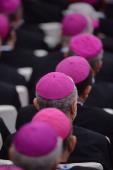
Pope Francis met with the leadership of the Council of Bishops’ Conferences of Latin America and the Caribbean, CELAM, which is holding its general coordinating meeting this week. The meeting was one of two appointments expressly desired by the Holy Father outside the context of World Youth Day, during his week-long visit to Rio for the World Youth Day celebrations. The first was a visit to the Marian shrine at Aparecida.
It was in Aparecida in 2007 that the CELAM bishops held their 5th General Conference, which produced a major three-part document outlining a plan for assessment of the situation of the Church in Latin America and implementing pastoral strategies to renew and revitalize the faith in the region. In his remarks to the CELAM leadership, Pope Francis said that the desired renewal is already underway in many particular Churches. His prepared address focused on the legacy of CELAM 5.
Please find the full text of Pope Francis’ prepared remarks, below:

